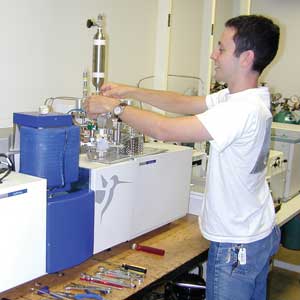|
FEATURE
Geologists Weigh in on Diet and Disease
Hope Jahren
 |
| At the Jahren Stable Isotope Laboratory at Johns Hopkins University, students such as Jon Wilson help trace isotopes through human blood to determine how specific foods may affect blood sugar. Photograph is courtesy of Hope Jahren. |
Geologists are among the healthiest people in the world. The Centers for Disease Control National Center for Health Statistics 2006 Report declares professional scientists, either in industry or education, as having the lowest incidence of illness, injury or job-related death when compared to all other U.S. jobs. According to the report, for every 200 scientists that worked full-time in 2005, only one missed work beyond her or his standard sick-time allocation because of illness or injury. In the next healthiest profession (financial services), rates are twice as high. So we can add this to the long list of things we love about geology and geologists: We’re an exceptionally healthy bunch.
The bulk of Americans aren’t doing nearly so well. Maladies that cause suffering and disability are epidemic, and include diabetes, obesity and cardiovascular disease. Although these diseases no longer routinely cause premature mortality, according to recent statistics, quality of life suffers and years are lost to misery and disability. Twenty-one million Americans are diabetic — that’s 7 percent of the population. An additional 20 percent of the population is “pre-diabetic,” exhibiting patterns in blood-sugar “misregulation” that point toward the near-term development of diabetes, according to the American Diabetes Association.
Even these numbers are dwarfed by the prevalence of cardiovascular disease: Eighty million Americans (that’s more than one-quarter of the population) have high blood-pressure, coronary heart disease or have had a stroke, according to the American Heart Association. About one-third of U.S. adults are now obese with body mass indexes over 30, and this percentage is fully double that from 20 years ago, according to the National Institutes of Health. Each of these diseases is epidemic, and the magnitude and severity of the problem increase each year.
 |
| Meat is an “energy dense” food that is increasingly consumed in the United States. According to the U.S. Department of Agriculture, per capita red meat consumption has doubled since 1950 and now stands near 140 pounds of edible meat per person per year. Since the 1970s, when high fructose corn syrup was first introduced into foods, usage of the corn-based sweetener has exploded and is found in all kinds of foods, including candy. New isotope research indicates that the sweetener and other energy dense foods may preferentially impact blood sugar. Photograph above is by Hope Jahren. Photograph below is by Megan Sever. |
 |
In one sense, the reasons are clear: Processed foods, large portion sizes, television and automobiles are at the root of these “diseases of overabundance” that the U.S. Department of Health and Human Services has been warning the public about since at least 1966. The task of making America healthier is daunting. Dietary intervention programs may succeed in the short term, yet ultimately fail due to the larger “obesogenic” environment, laden with fast food and sedentary leisure activities. It’s enough to make one as discouraged and pessimistic as, say, an environmentalist upon learning that carbon dioxide levels have increased by 20 percent just in the last 50 years, resulting in a greenhouse atmosphere the likes of which Earth has not experienced for at least 400,000 years … and did I mention that the Intergovernmental Panel on Climate Change projects the possibility of double today’s levels of carbon dioxide by 2100?
Thus the geoscientist and the medical researcher share the experience of calling for change against nearly insurmountable odds, armed with everything from shocking statistics to common sense. But the similarities don’t end there: Pedagogically speaking, asking the research question “What happens when an excess of sugar is eaten?” is not unlike asking “What happens when an excess of carbon dioxide is added to the atmosphere?” Research of the last ten years has brought unexpected answers to both questions.
With respect to earth systems, we’ve seen that seemingly unrelated processes are actually linked through the carbon cycle, and we’ve also found that elevated carbon dioxide is knocking some ecosystems out of equilibrium, even systems that aren’t carbon limited. (Increased concentrations of urushiol, the allergenic compound, in poison ivy within plots growing under elevated carbon dioxide is an excellent example of this.) Likewise, medical research on diabetes, obesity and cardiovascular disease has elucidated linkages between sugar metabolism and lipid metabolism that are increasingly complex. For example, recent research has suggested that a family history of coronary heart disease confers risk for Type-2 diabetes, above and beyond the risk conferred by familial history of diabetes alone. Another intriguing example of the complex links is that excess insulin associated with Type-2 diabetes results in increased bone mass, possibly because insulin receptors are expressed upon cells responsible for bone formation.
We all know that a diet laden with large portions of “energy-dense” foods will make you unhealthy, but much of the detailed relationship between diet and disease remains yet to be resolved. As an intriguing example, a “nutrition paradox” has presented itself as a growing phenomenon in some developing countries, where underweight children and overweight adults are occurring within the same family. The cheap, energy-dense, nutrient-poor foods (such as French fries and white bread) that stunt the growth of children provide excess calories for adults to gain excess weight, resulting in extreme weight discrepancies and poor health all around. Diet also carries life-long consequences, with poor fetal growth increasing the risk of obesity during adulthood, though the metabolic alterations responsible for this are not completely known.
Geoscientists can play a special role in contributing to medical research, using the integrative systems-based approaches pervasive to earth science. One such approach our team has been employing involves applying stable isotope geochemistry — a tool that was developed to follow Earth’s elements through complex cycles — to questions of blood sugar regulation, and misregulation, within the human body. We are very early in our research, but are learning fascinating things as we explore this field. For example, carbon-13 measurements within specific blood fractions show that fructose sugars preferentially impact blood products with low turnover rates, relative to other sugars. Clearly there’s still a lot to learn about the potential for the human body to treat individual sugars differently — for example, fructose versus glucose versus sucrose — and we need to throw away the simplistic dietary models that equate the nutritional potential of all foods in terms of “calories.”
Chemical biomarkers that integrate human processes are badly needed in order to test the myriad hypotheses surrounding the effects of diet on disease. For example, researchers have found a clear correlation between increased consumption of high fructose corn syrup in the modern diet and the increasing prevalence of obesity in the United States. Dietary monitoring of more than 12,000 people, however, did not show any consistent association between consumption of sugared beverages and Type-2 diabetes, according to a 2006 study in the American Journal of Epidemiology.
Our team has begun to pursue the idea that the unusually heavy carbon stable isotope signature of corn might propagate from corn syrup into human tissues in proportion to consumption, allowing us to follow this controversial compound through metabolic sugar regulation and misregulation processes. The carbon isotope signature of corn products, including high fructose corn syrup, is different from the average starch, and is thus traceable. Surveys of commonly consumed grocery store items reflect a diversity of carbon isotope compositions, with high fructose corn syrup products grouping as the highest values. Also encouraging is our finding that in a sample of anonymous adults (100 men and 100 women), a high percentage exhibit a diverse array of carbon isotope signatures in their blood, fully spanning the range of values seen in food sources.
Nonetheless, a wealth of work remains. We are looking into the carbon isotope variability in foods and food additives, as well as variability across human tissues and across humans with similar diets. We don’t yet know if a small amount of high-fructose corn syrup can be seen in human tissues, or if we can expect to see a change due to long-term consumption of the sweetener.
These are a new generation of dietary questions that will require a new suite of approaches. In the 1970s, Japanese food scientists synthesized high fructose corn syrup by isomerizing simpler sugars in a wholly artificial process. Their intention was to alleviate world hunger with engineered calories, and an unfortunate consequence may be an aggravation of the obesity epidemic. There’s opportunity here for the geoscientist to interact with the medical researcher and jointly approach these problems in terms of an anthropological disturbance of a natural system — the kind of discourse that’s all in a day’s work to the geoscientist.
One thing earth scientists are good at is dealing with the samples they already have instead of the ones they want (consider paleontology as an extreme sample of this). To this end, we have focused on learning what the carbon isotope composition of blood can tell us about an individual’s integrated diet, not because blood is necessarily the best long-term indicator of diet, but because it is accessible and renewable. Although geoscientists know much about stable isotopes in living tissues through paleodietary analysis for paleontology and archaeology, we need new collaborations with research doctors, epidemiologists and nutrition experts in order to test our ideas through clinical studies involving human subjects. And we’re beginning to see such collaborations more frequently. We must move forward with caution, however, learning the clinical requirements and protocols for conducting and reporting medical research, and conducting our studies within that context. (For example, how geoscientists commonly and traditionally structure their research is not going to translate into legitimate medical research results that can be acted upon in the public policy sphere.)
Dietary studies that rely on interviews and questionnaires are notoriously unreliable; literature dating back into the 1980s attempts to explain how patients can misrepresent home blood-sugar monitoring. For these reasons, relatively objective biomarkers that chemically reflect food consumption are enthusiastically sought and welcomed by medical researchers. Earth scientists, with our specialized tools and knowledge of integrated systems, have much to contribute to understanding the effect that the 21st century diet has on human health. With some good ideas, new collaborations and hard work, we can foster a future in which everyone might be as healthy as today’s average geologist.
Selected References and Links:
The EHG Program at Johns Hopkins University
The American Diabetes Association
The American Heart Association
Intergovernmental Panel on Climate Change
National Institutes of Health National Institute of Diabetes & Digestive & Kidney Diseases
Bray, G.A., Bouchard, C., and James, W.P.T., 1998, Handbook of Obesity: New York, Marcel Dekker.
Caballero, B., and Wang, Y., 2006, Commentary: Obesity and mortality--light at the end but still a long tunnel: International Journal of Epidemiology, v. 35, p. 21-22.
Caballero, B., 2006, “Obesity as a Consequence of Undernutrition”: The Journal of Pediatrics, v. 149, p. S97-S99.
Caballero, B., 2005, “A Nutrition Paradox—Underweight and Obesity in Developing Countries”: New England Journal of Medicine, v. 352, p. 1514-1516.
Caballero, B., 2004, Obesity prevention in children: opportunities and challenges: International Journal of Obesity, v. 28, p. S90-S95.
Jahren, A.H., Saudek, C., Yeung, E., Kao, W.H., Kraft, R., and Caballero, B., 2006, “An isotopic method for quantifying sweeteners derived from corn and sugar cane”: American Journal of Clinical Nutrition, v. 84, p. 1380-1384.
Kao, W.H.L., Kammerer, C.M., Schneider, J.L., Bauerd, R.L., and Mitchell, B.D., 2003, “Type 2 Diabetes Is Associated with Increased Bone Mineral Density in Mexican-American Women”: Archives of Medical Research, v. 34, p. 399-406.
Mohan, J.E., Ziska, L.H., Schlesinger, W.H., Thomas, R.B., Sicher, R.C., George, K., and Clark, J.S., 2006, “Biomass and toxicity responses of poison ivy (Toxicodendron radicans) to elevated atmospheric carbon dioxide”: Proceedings of the National Academy of Sciences, v. 103, p. 9086-9089.
Paynter, N.P., Yey, H.-C., Voutilainen, S., Schmidt, M.I., Heiss, G., Folsom, A.R., Brancati, F.L., and Kao, W.H.L., 2006, “Coffee and Sweetened Beverage Consumption and the Risk of Type 2 Diabetes Mellitus”: American Journal of Epidemiology, v. 164, p. 1075-1084.
The U.S. Senate’s Select Committee on Nutrition (1975): report on “Nutrition and Health.”
Yeung, E.H., Pankow, J.S., Astor, B.C., Powe, N.R., Saudek, C.D., and Kao, W.H.L., 2007, “Increased Risk of Type 2 Diabetes From a Family History of Coronary Heart Disease and Type 2 Diabetes”: Diabetes Care, v. 30, p. 154-156

 Subscribe
Subscribe


